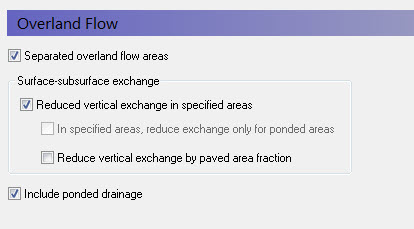
The main dialogue for overland flow includes several options when the Finite difference method is selected. It does not contain any options when the Sub-catchment based method is selected.
If the Finite Difference method is selected in the Simulation Specification dialogue, the basic items required for the calculation of Overland Flow are
· the Manning number, which is equivalent to the Stickler roughness coefficient,
· the Detention Storage, and
· the Initial Water Depth on the ground surface (ponded water).
There are three main options available in the Overland Flow dialogue.
Separated overland flow areas
The first allows you to divide the model area into overland flow zones, which are conceptually areas separated by dikes or embankments. With this option, overland flow will not be allowed to flow between zones. If this is checked, then an additional item, Separated Flow Areas (V1 p. 273), will be added to the data tree.
Surface-subsurface exchange
If the soil profile becomes completely saturated, then the unsaturated flow component, which normally controls surface-subsurface exchange, is no longer active. In this case, the overland flow module must exchange water with the saturated zone component directly. The surface-subsurface exchange option allows you to specify an exchange coefficient to reduce the exchange of water between the overland flow and the saturated zone. However, this coefficient is also taken into account when calculating vertical infiltration from ponded water to the unsaturated zone.
If the reduced vertical exchange option is chosen then a new item, the Surface-Subsurface Leakage Coefficient (V1 p. 269), must be specified.
In specified areas, reduce exchange only for ponded areas - An additional sub-item is also available that allows you to apply the exchange coefficient in sub-areas where it is only used when water is ponded. During rainfall, this will not have an effect, as the rainfall is always added to ponded storage first. However, after the rainfall, this will allow water to flow downhill along a drainage pathway with a reduced infiltration rate.

Note: This option is only available if you are using Multi-cell Overland Flow (V1 p. 490)
Reduced vertical exchange by paved area fraction - Paving is common in urban areas and has a significant impact on infiltration and runoff. This option allows you to additionally specify a paved area fraction that further reduces the infiltration in the cell by the fraction of paving.
When a Paved Area Fraction is specified, it is used as a linear scaling fraction for the Surface-Subsurface Leakage Coefficient. That is, the effective leakage coefficient is reduced by the Paved Area Fraction.
EffLeakCoef = (1-PAreaFrac) x SurfSubSurfLeakCoef
Ponded Drainage
In natural systems, runoff does not travel far as sheet flow. Rather it drains into natural and man-made drainage features in the landscape, such as creeks and ditches. Then, it generally discharges into streams, rivers or other surface water features. In urban areas, it may discharge into storm water retention basins designed to capture runoff.
The Ponded Drainage (OL Drainage) option was introduced in the 2017 Release to support conceptual drainage networks. Conceptually, the OL Drainage is the similar to the SZ Drainage in that a drainage network is calculated based on a downhill flow path from each node until it reaches a stream, a boundary, or a local depression.
Selecting this option creates additional sub-items in the data tree for the drainage options.
Related Items:
· Separated Flow Areas (V1 p. 273)
· Surface-Subsurface Leakage Coefficient (V1 p. 269)
· Overland Flow - Technical Reference (V1 p. 459)
· Working with Overland Flow and Ponding- User Guide (V1 p. 483)
· Overland and Ponded Drainage (V1 p. 501)
· Coupling of MIKE SHE and MIKE Hydro River (V1 p. 523)